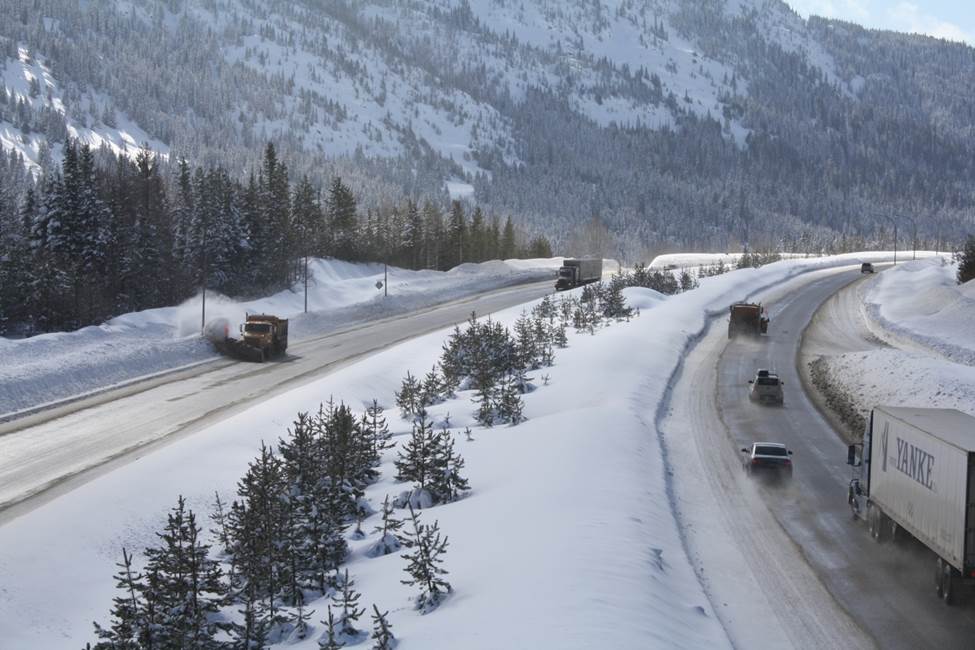
There are many kinds of highways in BC: Rural highways, urban highways, primary highways, secondary highways, freeways and expressways just to name a few. Each type of highway serves a different purpose. For example, a freeway is a divided primary highway built for through traffic (as opposed to local traffic access) with two or more lanes in each direction of travel. These lanes are accessible via interchanges only. A good example of a freeway is BC Highway 5, also known as the Coquihalla.
Divided freeways have many advantages, including:
- Efficient Movement. Because there are no left turn lanes, or driveway access points, freeways are able to move traffic efficiently over long distances.
- Decreased likelihood of head on collisions. Should a vehicle leave the road, they are less likely to impact other traffic.
- More opportunities for wildlife exclusion. We can install uninterrupted wildlife fencing, or encourage animals to use wildlife overpasses, or underpasses to keep them moving safely away from traffic.
- Better protection against rock falls – as they are typically built over wider terrain and with greater ditch width.
Despite these advantages, divided highways have one limitation:
- Limited access. In order for divided highways to move people quickly, efficiently and safely, they have to have limited access. That means no driveways along the route and no left turn lanes to get on or off the highway. Instead, drivers have to use a limited number of interchanges to get on (or off) the highway.
What does that mean to you? It means that if there’s an incident on a divided highway which closes the road ahead, you might find yourself stuck in traffic with no exit option available for some time. It also means that you should be prepared with warm clothes, food and enough gas to last as you sit tight in your car while we work to get the road back open for you. Incidents can happen at any time so always be aware of the road ahead as you travel. At times we have had an incident occur at a site, only to be followed by a more serious one right behind it because of speed, inattention and sight distance.
If you do find yourself stopped in traffic on the freeway due to an incident, please take the following actions to allow for emergency vehicles and plow trucks to access the site from behind you:
- On a divided highway with two lanes moving in one direction – move to the right if you are in the right lane and move to the left if you are in the left lane to let the emergency vehicles drive through the middle.
- On a divided highway with three lanes moving in one direction – move to the right if you are in either the centre or right lane and to the left if you are in the left lane to let the emergency vehicles through the middle.
If you are planning on travelling a divided highway, such as the Coquihalla, check out DriveBC, our traveller information system as well as weather forecasts and alerts before you go, so that you can be aware of any incidents or conditions that might delay you. You should also monitor the changeable message signs along the route and tune in to Radio 89.9 in the Merritt area for information on changing road information.
If you have any questions, let us know in the comments below.
Thanks, I just spent an hour on line including a review of the bc mv act to figure out where the “ fast/passing lane “ traffic in a divided highway is supposed to go if emergency vehicles approach from behind. I always understood that everyone pulled over to the right onto the shoulder. I now understand that the fast/passing lane car are to move to the left ( although if the divided highway is created by a concrete barrier there is not going to be much room to move over to the left). The question arose when traffic was slowed/stopped for an accident ahead and a firetruck came from behind. It was a gong show as 1/2 the fast lane moved to the left and the other half tried to move to the right and the firetruck ended up having to weave its way through. I still think the best approach is always drive in the right lane unless you are passing in the left lane
Hi Tom – thanks for your comment. You are correct that traffic should already be in the right hand (travel) lane – making it easier to pull over to the right for emergency vehicles. Many cars use the passing (left) lane for travel which can complicate things in an emergency.
Any further freeway construction… Please make sure they have grass strip medians.
Thanks for your request, Richard. I’ll forward it to our project people, for their consideration.
Vehicles should keep up steady pace when going past an accident of any kind.rather then every other car slow down as they pass by it only to take a look on whats going in or whats happened.because this slows done a long line of backed up traffic considerably.
Wisdom passed on to me by a paramedic:
They are not as concerned about which way you move out of the way, just make sure that you signal before moving and move in the direction of your signal.
A quick, simple hint — if you are stopped BEHIND an incident in a live lane of traffic (or even if you are slowed far below the posted speed due to an incident or crews working), activate your 4-way flashers as a means to further alert traffic coming up from behind you to your slowed/stopped status. This is especially true in poor visibility conditions.
A great tip Hardy – thanks for sharing!
Very informative, thank you for posting.
Glad to hear you found it useful Nick. Thanks!